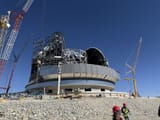Search Results
7/5/2025, 12:50:08 PM
>>16716460
>>16716412
Then you could say transit spectroscopy will always be limited. What is really needed to definitively find life is direct imaging. That doesn't mean seeing detail on the planet, just resolving it from it's host star so you can take spectra.
There is a lot on the horizon for direct imaging.
First there is WFIRST/Roman, which will have a coronagraph to block out the light of host stars. But it's only a technology test, it will not image rocky planets. Maybe some jupiter like ones. Roman is only JWST sized, and the instrument covers some visible and infrared. Little hope of finding life.
The bigger excitement is on the ground in the form of the European Southern Observatory's Extremely Large Telescope (ELT), at an 39 meters in diameter. Pic related is it a few weeks ago. It's really coming along. With adaptive optics it will beat JWST resolution by a factor of 6. On the ground coronagraph is harder, but working in the mid infrared there is some hope that ELT will be able to image rocky planets around some very close by M stars. This would be tremendous, if there are planets there. I wouldn't bet on it finding life, because the number of stars it can go deep enough is small. But to be seen, soon. They expect first light in 2029. ELT will transform a lot fields.
>>16716412
Then you could say transit spectroscopy will always be limited. What is really needed to definitively find life is direct imaging. That doesn't mean seeing detail on the planet, just resolving it from it's host star so you can take spectra.
There is a lot on the horizon for direct imaging.
First there is WFIRST/Roman, which will have a coronagraph to block out the light of host stars. But it's only a technology test, it will not image rocky planets. Maybe some jupiter like ones. Roman is only JWST sized, and the instrument covers some visible and infrared. Little hope of finding life.
The bigger excitement is on the ground in the form of the European Southern Observatory's Extremely Large Telescope (ELT), at an 39 meters in diameter. Pic related is it a few weeks ago. It's really coming along. With adaptive optics it will beat JWST resolution by a factor of 6. On the ground coronagraph is harder, but working in the mid infrared there is some hope that ELT will be able to image rocky planets around some very close by M stars. This would be tremendous, if there are planets there. I wouldn't bet on it finding life, because the number of stars it can go deep enough is small. But to be seen, soon. They expect first light in 2029. ELT will transform a lot fields.
Page 1
